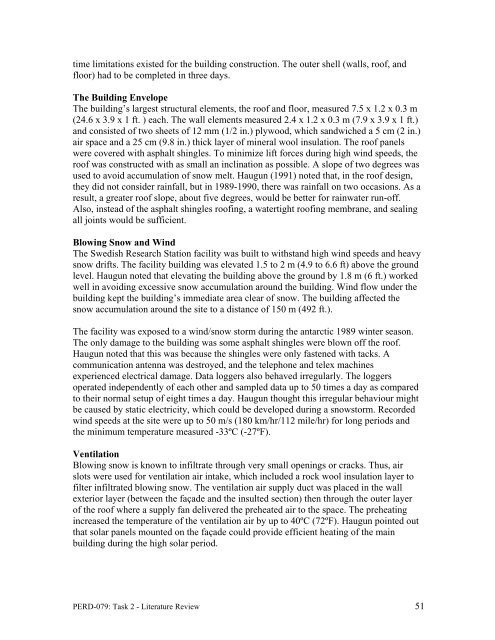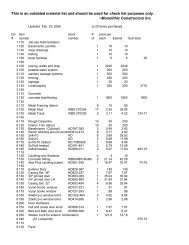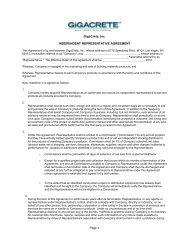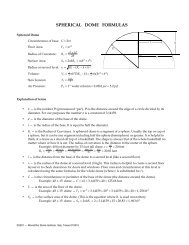Literature Review on Building Envelope, Heating and ... - Beeshive.org
Literature Review on Building Envelope, Heating and ... - Beeshive.org
Literature Review on Building Envelope, Heating and ... - Beeshive.org
Create successful ePaper yourself
Turn your PDF publications into a flip-book with our unique Google optimized e-Paper software.
time limitati<strong>on</strong>s existed for the building c<strong>on</strong>structi<strong>on</strong>. The outer shell (walls, roof, <strong>and</strong><br />
floor) had to be completed in three days.<br />
The <strong>Building</strong> <strong>Envelope</strong><br />
The building’s largest structural elements, the roof <strong>and</strong> floor, measured 7.5 x 1.2 x 0.3 m<br />
(24.6 x 3.9 x 1 ft. ) each. The wall elements measured 2.4 x 1.2 x 0.3 m (7.9 x 3.9 x 1 ft.)<br />
<strong>and</strong> c<strong>on</strong>sisted of two sheets of 12 mm (1/2 in.) plywood, which s<strong>and</strong>wiched a 5 cm (2 in.)<br />
air space <strong>and</strong> a 25 cm (9.8 in.) thick layer of mineral wool insulati<strong>on</strong>. The roof panels<br />
were covered with asphalt shingles. To minimize lift forces during high wind speeds, the<br />
roof was c<strong>on</strong>structed with as small an inclinati<strong>on</strong> as possible. A slope of two degrees was<br />
used to avoid accumulati<strong>on</strong> of snow melt. Haugun (1991) noted that, in the roof design,<br />
they did not c<strong>on</strong>sider rainfall, but in 1989-1990, there was rainfall <strong>on</strong> two occasi<strong>on</strong>s. As a<br />
result, a greater roof slope, about five degrees, would be better for rainwater run-off.<br />
Also, instead of the asphalt shingles roofing, a watertight roofing membrane, <strong>and</strong> sealing<br />
all joints would be sufficient.<br />
Blowing Snow <strong>and</strong> Wind<br />
The Swedish Research Stati<strong>on</strong> facility was built to withst<strong>and</strong> high wind speeds <strong>and</strong> heavy<br />
snow drifts. The facility building was elevated 1.5 to 2 m (4.9 to 6.6 ft) above the ground<br />
level. Haugun noted that elevating the building above the ground by 1.8 m (6 ft.) worked<br />
well in avoiding excessive snow accumulati<strong>on</strong> around the building. Wind flow under the<br />
building kept the building’s immediate area clear of snow. The building affected the<br />
snow accumulati<strong>on</strong> around the site to a distance of 150 m (492 ft.).<br />
The facility was exposed to a wind/snow storm during the antarctic 1989 winter seas<strong>on</strong>.<br />
The <strong>on</strong>ly damage to the building was some asphalt shingles were blown off the roof.<br />
Haugun noted that this was because the shingles were <strong>on</strong>ly fastened with tacks. A<br />
communicati<strong>on</strong> antenna was destroyed, <strong>and</strong> the teleph<strong>on</strong>e <strong>and</strong> telex machines<br />
experienced electrical damage. Data loggers also behaved irregularly. The loggers<br />
operated independently of each other <strong>and</strong> sampled data up to 50 times a day as compared<br />
to their normal setup of eight times a day. Haugun thought this irregular behaviour might<br />
be caused by static electricity, which could be developed during a snowstorm. Recorded<br />
wind speeds at the site were up to 50 m/s (180 km/hr/112 mile/hr) for l<strong>on</strong>g periods <strong>and</strong><br />
the minimum temperature measured -33ºC (-27ºF).<br />
Ventilati<strong>on</strong><br />
Blowing snow is known to infiltrate through very small openings or cracks. Thus, air<br />
slots were used for ventilati<strong>on</strong> air intake, which included a rock wool insulati<strong>on</strong> layer to<br />
filter infiltrated blowing snow. The ventilati<strong>on</strong> air supply duct was placed in the wall<br />
exterior layer (between the façade <strong>and</strong> the insulted secti<strong>on</strong>) then through the outer layer<br />
of the roof where a supply fan delivered the preheated air to the space. The preheating<br />
increased the temperature of the ventilati<strong>on</strong> air by up to 40ºC (72ºF). Haugun pointed out<br />
that solar panels mounted <strong>on</strong> the façade could provide efficient heating of the main<br />
building during the high solar period.<br />
PERD-079: Task 2 - <str<strong>on</strong>g>Literature</str<strong>on</strong>g> <str<strong>on</strong>g>Review</str<strong>on</strong>g> 51












